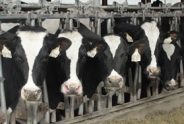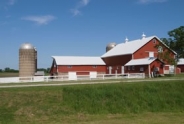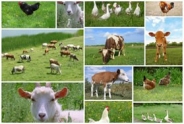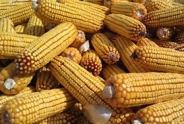Poultry Processing Waste Management via Composting
Amy Barkley, Team Leader & Livestock Specialist
Southwest New York Dairy, Livestock and Field Crops Program
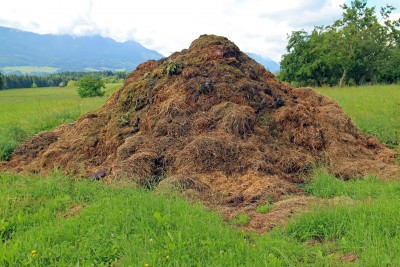
Now that the weather is finally consistently warm and pastures are lush, most producers of pastured broilers and ducks are harvesting their first flocks or beginning their flock rotation cycles. Those who are raising turkeys and geese are also getting ready to or have already placed their birds in preparation for the fall and winter holiday seasons. As the harvest windows for these birds arrive, producers processing their own birds or processing birds for others need to arrange for a way to dispose of the waste from processing. These waste products include blood, feathers, offal, heads, feet, rinse water, and cooling water and must be properly dealt with to reduce their environmental impact. Additionally, and fortunately, what we traditionally may see as waste products can go on to live a second life as nutrients for other crops on the farm though composting while eliminating the costs of having to pay for other disposal services.
Waste Water Management
During processing, waste water from both rinsing and chilling should be collected, especially if the processing area is outdoors and within 200' of a well, stream, pond, or other water body or environmentally sensitive area. Collected water can be applied to an actively growing hayfield, which provides enough vegetation and root mass to sequester most of the nutrients from the water, which include nitrogen, phosphates, and dissolved organics. In this case, the water effectively acts as a liquid fertilizer for the hayfield. It is not recommended that this product be applied to vegetable gardens since larger pieces of organic matter, including feces, fat, and blood, can potentially carry disease causing organisms if the produce in contact with the waste water is harvested too close to the window of waste water application. If the processing area is not near a waterway, water body, or environmentally sensitive area, and is surrounded by grass or other dense vegetation, the water can be allowed to flow naturally into these vegetative buffers. The buffers will absorb much of the nutrients carried in the waste water and reduce potential runoff.
Composing
Composting is a process by which cycles of natural heating and microbial degradation within an oxygen-rich environment composed of carbon and nitrogen-rich materials reduce waste into an organic matter concentrated, nutritionally available, biosecure fertilizer. The process takes between 4 and 6 months to complete. If done properly, a compost pile should have next to no odor, problems with scavengers, or problems with nutrient runoff.
The process of building a compost pile is import to ensure its success. After selecting a location that is 200 feet from streams, ponds, and environmentally sensitive areas, a 24-inch deep base of carbon rich material (wood chips, wood shavings, hay, or animal bedding) must be laid down. The width of the pile will depend on the amount of waste produced. Generally, waste should be applied in layer which is no more than 12-15 inches deep, with a 24-inch buffer of carbon material around the perimeter. Piles can be as wide as 10-16 feet, but this may be too large for smaller operations. New piles don't have to be made for each processing day; one pile can keep being added to over the course of a few months or a season.
The compost pile can be built to be multiple layers deep. Starting with the 24-inch deep base of carbon-rich material, a 12-15 inch deep layer of waste can be added, followed by a 12-18 inch deep layer of carbon-based material, then another 12-15 inch deep layer of waste. If adding blood to the pile, err on the deeper side of carbon-rich material and the more shallow side of the waste layer to allow for the wood or straw to soak up the liquid. The final layer on the pile will be a layer of carbon material that is 2 feet deep. The finished pile will be between 5 and 6 feet high. Not all layers need to be added at one time. However, keep in mind that a 2 feet deep layer of carbon material should be placed on top of whatever section being worked on at the end of the day to discourage scavengers.
Once the pile is built, it will heat up to around 130-135⁰F, which will destroy viruses, bacteria, weed seeds, and fly larvae. It will then cool down gradually. Temperatures can be monitored with a composting thermometer, which is long enough to reach the interior of the pile where the highest rate of composting is occurring. A second temperature spike to allow for more complete composting can be achieved by turning the compost pile after 3 months.
After 4-6 months, the pile can be checked for completeness of composting. This can be done by verifying that the temperatures are remaining slightly over ambient air temperatures. If opening the pile to check, the majority of the processing waste should be degraded. If properly composted, most of the processing waste will have been transformed into a rich dark brown humus. Bones may remain if processing older aged fowl, since they are more calcified and take more time to break down. If any bones remain, they will be limited to larger bones if the process has occurred properly. These bones can be picked out before the compost is used and incorporated into the next pile to undergo a second composting. Over time, these bones will degrade.
Composting is an art as much as it is a science. Incomplete composting may be caused by a variety of reasons including not enough carbon, too much carbon, improper piling, not enough air flow, time of year, too much liquid, not enough moisture, etc. When composting, it's a good idea to keep a log of materials used, materials composted, depths of layers, time of year the pile was made, when it was turned, and what the temperature spikes were. This information can be reviewed by your local extension agent to help determine why the composting process may have failed.
For more information on composting poultry processing waste, other butchery waste, and livestock mortalities, visit the Cornell Waste Management Institute Website at http://cwmi.css.cornell.edu/mortality.htm
Upcoming Events
Boots in the Barn: Cornell Dairy Research Updates
January 13, 2026
January 20, 2026
January 27, 2026
February 3, 2026
February 10, 2026
February 17, 2026
February 24, 2026
Join us for some or all!
Advanced Hoof Health Program
January 15, 2026
Belfast, NY
Who should attend?
- Professional hoof trimmers
- Dairy farm owners or managers in charge of farm foot health
Topics include:
- How to Create a Strategic Trimming Program for your Dairy
- The Latest in Lameness Technology for the Dairy Industry
- Housing and Flooring Design: Its Role in Hoof Care
NY Pork Producers Connection Breakfast - Geneseo
January 17, 2026 : Pork Producers Connection Breakfast - Geneseo
Geneseo, NY
All pork producers are invited to join the New York Pork Producers for a free hot farmer's breakfast, at which they'll catch up on topics including the pork to dairy barn conversion series, NYPP digital campaigns, and 840-RFID tags.
Announcements
No announcements at this time.


